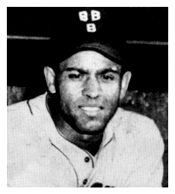

James Zapp
Nickname: Jim, Jimmy, Zipper
Career: 1945-1954
Positions: 3b, lf, rf
Teams: military service (1942-1945), Baltimore Elite Giants (1945-1946, 1950-1951, 1954), Nashville Cubs (1946), Atlanta Black Crackers (1947), Birmingham Black Barons (1948, 1954), semi-pro teams (1949-1950), minor leagues (1952-1955)
Bats: Right
Throws: Right
Height: 6' 2'' Weight: 208
Born: April 18, 1924, Nashville, Tennessee
After this big, hard-hitting outfielder slugged 11 homers with the Negro Southern League’s Atlanta Black Crackers in 1947, he attracted the attention of the Birmingham Black Barons and won an outfield position with the team the following spring. His bat helped Birmingham nail down the Negro American League title when, in the fifth game of the league championship series against the Kansas City Monarchs, he homered in the bottom of the ninth inning to tie the ball game, opening the door for another Black Baron tally in the last frame to win a 4-3 thriller and give Birmingham a 1-game edge in the playoffs.
During the regular season, Black Barons' manager Piper Davis had given Zapp a rest and inserted a teenage rookie named Willie Mays in his left-field spot for the second game of a doubleheader. Later in the season, when center fielder Norman Robinson broke his leg, Mays stepped into the breach and used the opportunity to demonstrate his defensive skills on an everyday basis. Although Mays had trouble hitting a curve and was not a significant offensive factor, his fielding earned him the starting position in center field. When Robinson eventually returned to the lineup, he was inserted into left field to utilize his speed and glove, and Zapp was displaced from the starting lineup for a short time. Fortunately, he returned in time to deliver the big blow in the playoffs. After securing the pennant, the Black Barons lost the World Series to the Negro National League champion Homestead Grays.
During the next two seasons he play with semi-pro teams in the Nashville area, including the Morocco Stars in 1949 and the Nashville Stars in 1950. During the latter part of the 1950 season he returned to the Baltimore Elite Giants when they were in the Negro American League after a realignment, and remained with them in 1951. Zapp had begun his professional career with the Elite Giants in 1945, when they were in the Negro National League, after his discharge from the Navy. He had begun playing baseball in 1942 while stationed in Hawaii, and his Navy team won back-to-back championships in 1943-1944.
In 1952 he entered organized baseball with Paris in the Mississippi-Ohio Valley League, where he hit .330 and slammed 20 home runs with 136 RBIs. His temperament, which had always contributed to problems while he was playing, continued to plague him after leaving the Negro Leagues. In his second season in the Mississippi-Ohio Valley League he began with Danville but played only briefly before joining Lincoln in the Western League, also for a brief time. But in 1954 and 1955 he enjoyed two more big seasons, batting .290 with 32 home runs in 90 games and .311 with 29 home runs in 89 games, with Big Springs in the Longhorn League. In the latter season he also played with Port Arthur in the Big State League, adding another 8 homers in 39 games to close out his organized baseball career.
In 1954 the slugging outfielder went back to the Negro American League for the latter part of the season, playing with the Elite Giants and the Black Barons during the last month of the season. By then, however, the Negro American League was no longer a major league operation.
Baseball Career Highlights:
"The highlight of my career was in 1948 when I was playing with the Birmingham Black Barons against the Kansas City Monarchs. It was in the third game of the playoffs. I hit a home run in the bottom of the ninth inning to win the game."
Professional/Personal Accomplishments:
"I began playing integrated baseball in 1952 with the Mississippi/Ohio Valley League, which is now called the Midwest League. With a.330 batting average, I led the league in home runs and set a RBI league record with 136 that still stands. In 1954, I played in the Long Horn League and set a team record with 32 home runs."
"Going to work for the U.S. Air Force's Civil Service Division in Big Springs, Texas, in 1956, I became a sports director. I retired in 1979. In addition, I coached youth baseball and umpired for 20 years."
Sources:
NLBM Legacy 2000 Players' Reunion Alumni Book, Kansas City Missouri: Negro Leagues Baseball Museum, Inc., 2000.
James A. Riley, The Biographical Encyclopedia of the Negro Baseball Leagues, New York: Carroll & Graf Publishers, Inc., 1994.

Jim Zapp